
Career Map Surprised OSIRIS-REx Scientist
By Doug CarrollCareer Map Surprised OSIRIS-REx Scientist
×
By Doug Carroll, University Relations - Communications, September 6, 2016
CAPE CANAVERAL, Fla. — It's a long, long, l-o-n-g way from El Paso Community College to the asteroid Bennu, but Daniella DellaGiustina has covered the distance.
The University of Arizona alumna, a self-described "military brat" who recalls making Girl Scout trips to the Flandrau Science Center & Planetarium on the UA campus, is the lead image processing scientist for the OSIRIS-REx asteroid sample return mission. As such, she will be involved in mapping the asteroid down to the ability to see an object the size of a penny on its surface. The adventure begins with Thursday's scheduled launch of the spacecraft aboard an Atlas V rocket at Cape Canaveral Air Force Station.
The UA-led mission, 12 years in the making, hopes to collect at least 60 grams (about 2 ounces) of surface material from the carbon-rich Bennu, which is about 150 million miles away and will take two years to reach. When the sample returns to Earth in 2023, it could yield clues to the origins of the solar system and life itself.
DellaGiustina, who graduated from the UA in 2008 with a bachelor's degree in physics, was only slightly less than 150 million miles from a career in planetary science at one point. Headed toward a liberal-arts major, she wasn't even on science's radar until she took a community college class in astronomy simply to get a general-education requirement out of the way.
"It sparked in me a curiosity that's still very much alive," DellaGiustina said after participating on a three-person mission science panel Tuesday at Kennedy Space Center. "I was so amazed and surprised by how abstract the universe is, and how much we don't know, and how science can answer some of these fundamental philosophical questions - Where did we come from? What is our future? - in a way that I did not recognize before.
"After that point, I made the decision that I wanted to study space science, and I transferred to the UA because it's renowned for astronomy, planetary science and optical science."
She remembers looking up at the big Arizona sky in wonderment during the years of her childhood that were spent in the Sierra Vista area.
"I have these memories of how incredibly clear the skies were and how seeing the Milky Way was just a part of my life," DellaGiustina said. "Southern Arizona is a place where you can see the stars."
When DellaGiustina was a UA undergraduate, Dante Lauretta and the late Michael Drake showed her "how to do science within engineering constraints," she said. Drake died in 2011 only four months after the UA had been awarded the OSIRIS-REx mission by NASA, to be succeeded as principal investigator by Lauretta.
DellaGiustina went on to the University of Alaska for a master's degree in computational physics before returning to the UA as a research scientist in 2012. She joined the Lunar and Planetary Laboratory in 2014.
She is one of several women to play key roles in the OSIRIS-REx mission. Others include Sara Knutson, an operations engineer and alumna of the UA College of Engineering; Catherine "Cat" Merrill, formerly deputy project manager for the UA-built OSIRIS-REx Camera Suite, or OCAMS; and Heather Enos, who will succeed Ed Beshore in October as deputy principal investigator for the mission.
Although the field of space science tends to be heavily populated by men, DellaGiustina said she never has felt shortchanged of opportunities.
"As a Hispanic female, I have to say I didn't have a tremendous amount of role models growing up to demonstrate that a career in the physical sciences was a possibility," she said. "But I never felt like doors have been closed for me."
Lauretta said he sees much of himself in DellaGiustina's career arc and work ethic, describing her as "one of my go-to people" on OSIRIS-REx. Both were NASA Space Grant interns at the UA who identified an affinity for meteoric science as undergrads.
"Her life story was very similar to mine," Lauretta said. "My job was to give her opportunity."
The mapping role for OSIRIS-REx presents a unique set of challenges for DellaGiustina.
"Mapping has typically taken place on Earth, Mars and other very large spherical bodies using tools that do everything in 2-D, measuring in latitude and longitude," she said. "But an object like Bennu is not particularly spherical, so when we try to flatten it into two dimensions, the latitude and longitude don't necessarily address points on the surface. ... A lot of software for mapping is not exactly wired to do this work."
Perhaps it takes an avid rock climber, then, to take the full measure of one big space rock.
"It's really common in rock climbing to try to think about lowering the risk of what you're going to do," said DellaGiustina, who has been a director for the Climbing Association of Southern Arizona.
"A lot of what we've done with OSIRIS-REx has been to try to mitigate risk upfront, to think through problems ahead of time so that we're prepared for what's in store for us."
Bradley Williams, another recent UA graduate (2013, College of Engineering), has worked alongside DellaGiustina on OSIRIS-REx and said no one could be better prepared.
"She's always reaching out for more," Williams said. "She'll work more hours than anybody. She's really into it. I like working with people with a passion like hers."
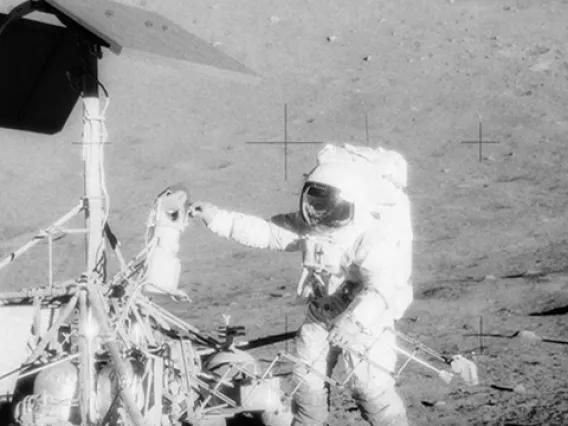
NASA's Surveyor Lander Brought the Moon to the World
By Robin TricolesNASA's Surveyor Lander Brought the Moon to the World
×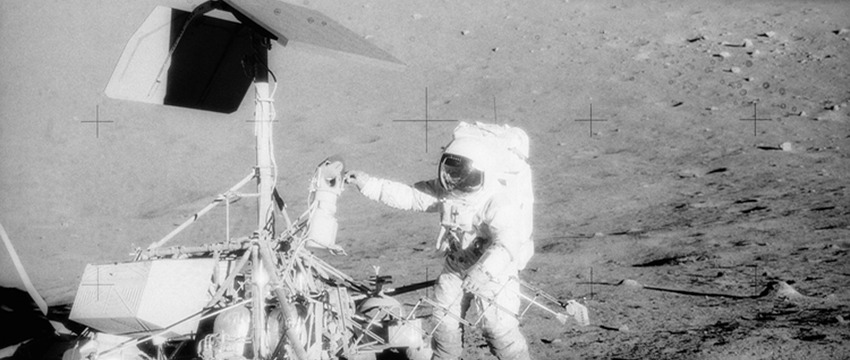
By Robin Tricoles, University Relations - Communications, August 17, 2016
While their colleague Richard F. Gordon was busy orbiting the moon in Apollo 12's command module in late 1969, fellow astronauts Charles Conrad and Alan Bean decided to take a little stroll. They exited Apollo 12's lunar module and moseyed across the lunar surface to Surveyor 3, which was parked right where it had landed two and a half years earlier.
Conrad and Bean snapped photos of the little lander and of each other. Afterward, the two harvested Surveyor 3's camera, some of its cable and tubing, and its trenching scoop and made tracks back to their craft. The astronauts spirited their haul back to Earth, where researchers and technicians would study how the lunar environment had affected the assorted parts.
NASA's Surveyor program, which ran from June 1966 through January 1968, consisted of seven lunar camera-equipped flights in support of the upcoming manned Apollo landings. The intent was to find a way to safely land men on the moon. Five of the spacecraft made it; two didn't.
But of the five craft that did, they transmitted about 92,000 digital images back to Earth via television cameras. In turn, those images were put on film and the digital data forgotten about. After all, back in the 1960s, hardcopy - film in this case - ruled the day.
"When the data came back, it was digital to begin with because it had to be transmitted back to Earth," says Shane Byrne, associate professor in the University of Arizona's Lunar and Planetary Laboratory and lead scientist on the project.
"Once they printed it out and put it on film, they forgot about the digital data, and it got lost over time because why would you need the digital data? That was the thinking at the time. The 1960s was sort of the Wild West of space exploration, and that made it very fun and exciting."
Now the UA's Space Imagery Center in LPL is digitizing the film and putting the final touches on those images. Soon they will be available to researchers and the public throughout the world.
Those final touches include collecting specific data, such as instrument temperature, time of day and camera-pointing angle, to accompany each and every frame. "Alongside each image, there will be printed information about it," Byrne says. "That is valuable information to use later, so you know what you're looking at."
In fact, Ewen Whitaker, a retired LPL research scientist, used those films and others from the Lunar Orbiter program to locate Surveyor 3 so that NASA could land an Apollo spacecraft nearby.
"NASA had no way of knowing where the moon spacecraft were," Byrne says. "Ewen took the pictures from the Surveyor spacecraft so he could pick out mountains and craters and things like that. And then he looked at the overhead images from Lunar Orbiter to try to pick out the same features and figure out where the landers were."
Because the approximately 30 reels of 70-millimeter film were slowly degrading over time, it became increasingly important to convert the film into digital format.
"And the data themselves are important because we've landed on only a handful of locations on the moon," Byrne says. "But if you wanted to see the data, that meant coming here and pulling a spool of film off a shelf.
"We didn't realize the images weren't available digitally online because almost everything is. It certainly was a shock to find that these images weren't available to everybody."
Justin Rennilson, co-investigator on the original Surveyor television experiment, was the one who approached researchers about digitizing the images. Byrne wrote a proposal to get the job done and NASA funded it. Shortly thereafter, in the spring of 2015, John Anderson, a media technician at the Space Imagery Lab, and Maria Schuchardt, the center's program manager, began scanning the film.
There are two main types of terrain on the moon, Byrne says.
"All of the Apollo missions and most of the Surveyor missions went to one type: the lunar mare, the dark areas of the moon," he says. "It's smoother and safer to land there, and that was the motivation for sending the astronauts there. But most of the moon is covered with the bright areas, the lunar highlands, which is most of what you see when you look up. The bright areas are much rougher, much more cratered. So none of the Apollo landings were made there."
Once all the data are archived, scientists will be able to assemble a mosaic of all the images, Byrne says.
"You'll have a full panorama, and you can even watch how it changes as the sun moves across the sky," he says. "I think it's great because the moon is so local. It's right next door."
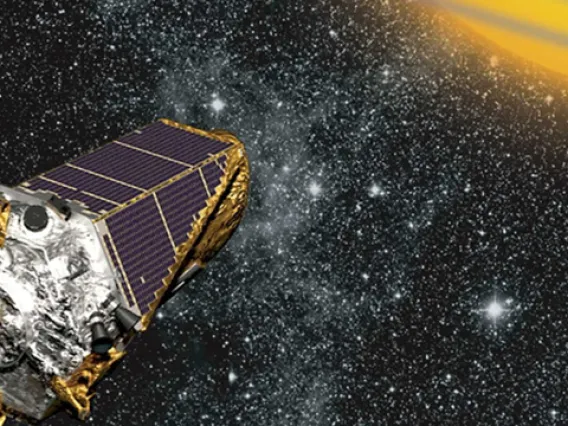
UA-Led Team Confirms 100+ Exoplanets Via Kepler
By Daniel StolteUA-Led Team Confirms 100+ Exoplanets Via Kepler
×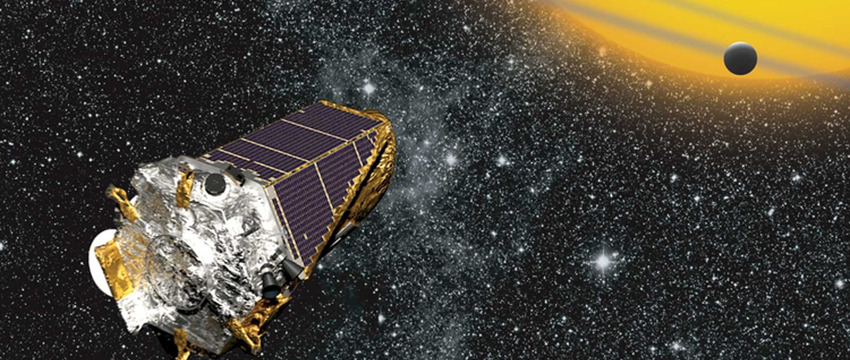
By Daniel Stolte, University Relations - Communications. July 18, 2016
An international team of astronomers led by the University of Arizona has discovered and confirmed a treasure trove of new worlds using NASA's Kepler spacecraft on its K2 mission. Among the findings tallying 197 initial planet candidates, scientists have confirmed 104 planets outside our solar system. Among the confirmed is a planetary system comprising four promising planets that could be rocky.
The planets, all between 20 and 50 percent larger than Earth by diameter, are orbiting the M dwarf star K2-72, found 181 light-years away in the direction of the Aquarius constellation. The star is less than half the size of the sun and less bright. The planets' orbital periods range from five and a half to 24 days, and two of them may experience irradiation levels from their star comparable to those on Earth. Despite their tight orbits - closer than Mercury's orbit around the sun - the possibility that life could arise on a planet around such a star cannot be ruled out, according to lead author Ian Crossfield, a Sagan Fellow at the UA's Lunar and Planetary Laboratory.
The researchers achieved this extraordinary "roundup" of exoplanets by combining data with follow-up observations by Earth-based telescopes including the North Gemini telescope and the W. M. Keck Observatory in Hawaii, the Automated Planet Finder of the University of California Observatories, and the Large Binocular Telescope operated by the UA. The discoveries are published online in the Astrophysical Journal Supplement Series.
Both Kepler and its K2 mission discover new planets by measuring the subtle dip in a star's brightness caused by a planet passing in front of its star. In its initial mission, Kepler surveyed just one patch of sky in the Northern Hemisphere, measuring the frequency of planets whose size and temperature might be similar to Earth orbiting stars similar to our sun. In the spacecraft's extended mission in 2013, it lost its ability to precisely stare at its original target area, but a brilliant fix created a second life for the telescope that is proving scientifically fruitful.
After the fix, Kepler started its K2 mission, which has provided an ecliptic field of view with greater opportunities for Earth-based observatories in both the Northern and Southern hemispheres. Additionally, the K2 mission is entirely community-driven with all targets proposed by the scientific community.
Because it covers more of the sky, the K2 mission is capable of observing a larger fraction of cooler, smaller, red-dwarf type stars, and because such stars are much more common in the Milky Way than sun-like stars, nearby stars will predominantly be red dwarfs.
"An analogy would be to say that Kepler performed a demographic study, while the K2 mission focuses on the bright and nearby stars with different types of planets," Crossfield said. "The K2 mission allows us to increase the number of small, red stars by a factor of 20, significantly increasing the number of astronomical 'movie stars' that make the best systems for further study."
To validate candidate planets identified by K2, the researchers obtained high-resolution images of the planet-hosting stars as well as high-resolution optical spectroscopy data. By dispersing the starlight as through a prism, the spectrographs allowed the researchers to infer the physical properties of a star - such as mass, radius and temperature - from which the properties of any planets orbiting it can be inferred.
These observations represent a natural stepping stone from the K2 mission to NASA's other upcoming exoplanet missions such as the Transiting Exoplanet Survey Satellite and James Webb Space Telescope.
"This bountiful list of validated exoplanets from the K2 mission highlights the fact that the targeted examination of bright stars and nearby stars along the ecliptic is providing many interesting new planets," said Steve Howell, project scientist for Kepler and K2 at NASA's Ames Research Center in Moffett Field, California. "This allows the astronomical community ease of follow-up and characterization, and picks out a few gems for first study by the James Webb Space Telescope, which could perhaps provide information about their atmospheres."
This work was performed in part under contract with the Jet Propulsion Laboratory, or JPL, funded by NASA through the Sagan Fellowship Program executed by the NASA Exoplanet Science Institute.
NASA Ames manages the Kepler and K2 missions for NASA's Science Mission Directorate. NASA's Jet Propulsion Laboratory in Pasadena, California, managed Kepler mission development. Ball Aerospace & Technologies Corporation operates the flight system with support from the Laboratory for Atmospheric and Space Physics at the University of Colorado, Boulder.
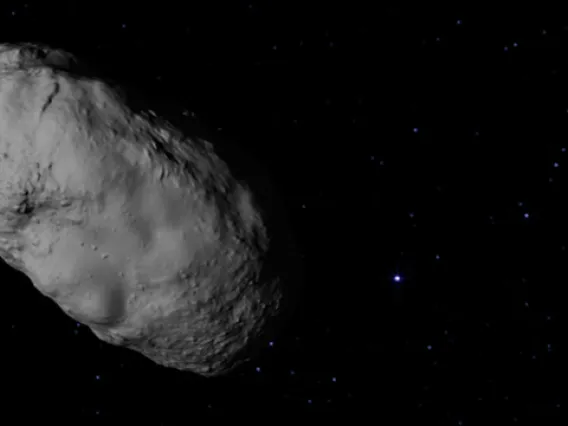
Bennu: How a Little Asteroid Became a Rock Star
By Robin TricolesBennu: How a Little Asteroid Became a Rock Star
×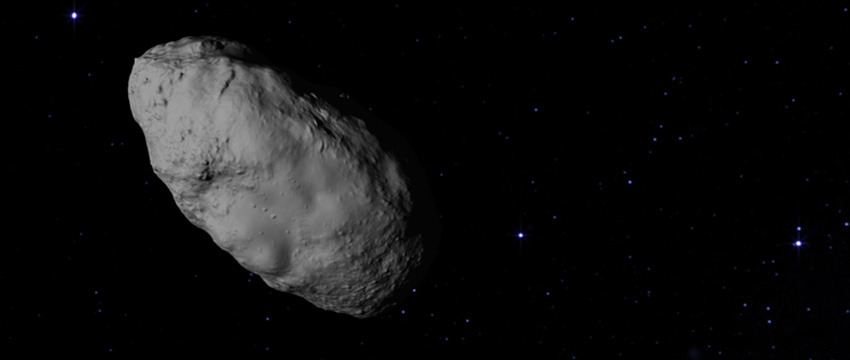
By Robin Tricoles, University Relations - Communications, June 29, 2016
Carl Hergenrother fingers a stack of white, 8 1/2- by 11-inch paper that sits before him on his desk. As he flips through the inch-thick dossier, lines of type are clearly visible.
"This is everything we know about Bennu," says Hergenrother, glancing down at the pile of paper.
Hergenrother is a staff scientist at the University of Arizona's Lunar and Planetary Laboratory. Bennu is an asteroid and a small but distinct resident of our solar system – so distinct that it was chosen as the destination for the OSIRIS-REx mission.
The OSIRIS-REx spacecraft is set to launch in September and in 2020 pick up a sample of the asteroid's regolith, the loose soil and rocky material found on its surface. The sample then will be returned to Earth for analysis.
Scientists discovered Bennu on Sept. 11, 1999, by using electro-optical telescopes operated by the Massachusetts Institute of Technology Lincoln Near-Earth Asteroid Research, or LINEAR, program. The asteroid originally was known as 1999 RQ36.
Hergenrother played a key role in choosing Bennu for the OSIRIS-REx mission. The first time he laid eyes on the asteroid, it was 2005, and 1999 RQ36 was cruising close to the Earth as it does every six years. Through the Kuiper telescope on Mount Bigelow, Bennu appeared as no more than a dot of light, "like a star that moves," Hergenrother says.
After all, an asteroid is simply a "rock in space," he says.
Not Your Average Space Rock
But in many ways, Bennu is a special rock.
It was 2004 when the late Michael Drake, director of the Lunar and Planetary Lab, proposed securing a sample of a near-Earth asteroid. But back then, no one knew much about Bennu. In fact, researchers were considering an assortment of other asteroids, specifically ones rich in carbon.
"We want to go to a particular type of asteroid, a carbonaceous asteroid," Hergenrother says. Researchers also want that asteroid to be rich in volatiles – substances that boil off easily, like water.
"The thinking is that these are the kinds of objects that in the early days of the solar system seeded the Earth with the organics that life formed from, as well as the water needed," says Hergenrother, cautioning that there is still some debate about the matter.
"But we hope that Bennu is what we would call a time capsule, that it hasn't changed much over the history of the solar system and will show what materials looked like in the very early days of solar system."
Hergenrother became Bennu's champion after years of data collection and analysis – and a good deal of deductive reasoning. He served as coordinator for the mission, but much of the observation and deduction fell to other mission scientists.
"We're now approaching a million known asteroids," Hergenrother says. "That wasn't the case when we started doing this 12 years ago. But we were still talking hundreds of thousands of asteroids at that time."
However, the researchers didn't have to analyze nearly so many. Most of them could be quickly eliminated by their stark faults, such as residing too far from Earth. Closer asteroids allow for the completion of a mission within a reasonable amount of time. That criterion alone left only a couple thousand asteroids that remained viable candidates for exploration, Hergenrother says.
And of those, many have orbits that are less than stellar.
"They're too far from the sun or too close to the sun," Hergenrother says. "Or they're at a sharp angle to the Earth, which would take a more powerful rocket to get into that kind of orbit."
Looking for 'Favorable Orbits'
Which, in turn, left only a few hundred objects that have favorable orbits – that is, ones residing near the Earth and remaining a favorable distance from the sun. However, most of those objects are too tiny.
"Some are as small as a desk," Hergenrother says. "The ones smaller than about 200 meters have a habit of rotating very fast. The fastest ones we know about rotate about every 16 seconds."
That's too fast to accommodate a spacecraft looking for a sample of regolith.
But Bennu rotates only once every 4.3 hours, slow enough to sample its regolith.
"So, once you eliminate the small guys, you look at the bigger ones that have very Earth-like orbits," Hergenrother says. "Now you're talking only dozens of candidates, and we wanted to go to one that's carbonaceous.”
Which Bennu seems to be. Its carbonaceous nature sent it to the top of the list of asteroids, says Hergenrother, who emailed Drake and Dante Lauretta, saying, "Guys, this is carbonaceous. It's looking good. And there's radar data."
Lauretta, professor of planetary science and cosmochemistry at the Lunar and Planetary Laboratory, is Drake's successor as the principal investigator for the OSIRIS-REx mission.
The data showed Bennu having a polar diameter of 508 meters, a mean diameter of 492 meters and an orbital velocity of more than 28 km per second. It also showed that the asteroid has a spinning-top shape; that is, it sports a bulge along its equator, a common feature among near-Earth asteroids.
"What we think this means is that this is a rubble-pile object," Lauretta says, meaning that Bennu probably is made out of many boulders tens to hundreds of meters across.
The boulders "are loose, and they’re responding to the forces of the asteroid spinning, and material is migrating from the pole of the asteroid and accumulating at the equator and building up a ridge," Lauretta says.
Life Expectancy: 10 Million More Years
For better or worse, Bennu has an unstable orbit. That means it probably won’t last more than 10 million years before it collides with Earth or another planet, or falls into the sun, according to Lauretta.
This is a concern to scientists. In fact, Bennu is considered a potentially hazardous object and has a relatively high possibility of impacting the Earth. So scientists are interested in understanding how asteroids' orbits evolve.
Key to that evolution is something known as the Yarkovsky effect.
"Which is simply that an asteroid receives energy from the sun, turns that energy into heat, and as it rotates into the afternoon throws that energy back into space as thermal energy, and that acts like a thruster and changes the orbit of the asteroid slowly but surely over time," Lauretta says. "If you want to know where an asteroid is going to be in the future, particularly in our future, then you want to know about the Yarkovsky effect."
Looking back on his quest to help select an asteroid suitable for sampling, Hergenrother says he sometimes thinks about what if there were no Bennu.
"There are only three carbonaceous objects that are easy to get to," he says. "They all seem to be the same shape. They all seem to be relatively safe targets. They're scientifically interesting, and they're easy to get to. But that's only three out of nearly a million."
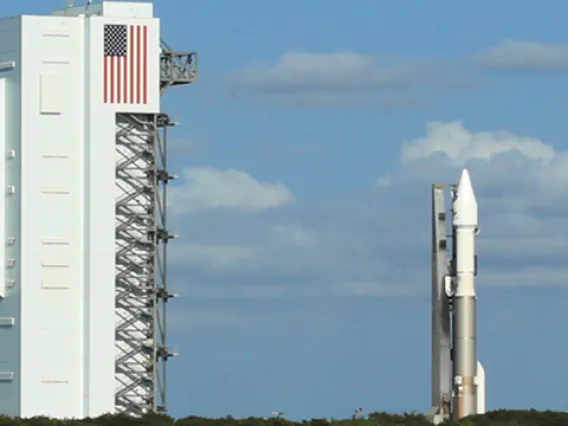
Michael Drake's Dream Takes Off
By Doug CarrollMichael Drake's Dream Takes Off
×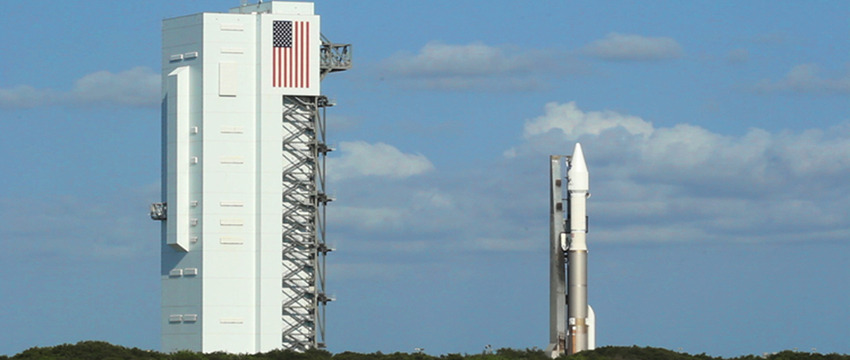
By Doug Carroll, University Relations - Communications, September 7, 2016
CAPE CANAVERAL, Fla. - The embodiment of the late Michael Drake's biggest questions about the universe lifted off in coastal Florida's sunshine on Wednesday, September 9, 2016 at 4:05 pm,
A sleek Atlas V 411 rocket, topped by a Lockheed Martin spacecraft, was slowly rolled out in midmorning from United Launch Alliance's Vertical Integration Facility - a space-age hangar - to Space Launch Complex 41 at Cape Canaveral Air Force Station. The OSIRIS-REx mission, conceived by Drake 12 years ago and finally green-lighted by NASA only four months before his death in 2011, is the first U.S. mission to send a robotic spacecraft to retrieve a sample from a primitive carbonaceous asteroid.
In his 38-year tenure at the University of Arizona, the English-born Drake studied lunar rocks, meteors and the moons of Saturn. He helped map the surface of Mars. But nothing captured his imagination quite like an asteroid sample return mission, which he thought would reveal significant clues to the origin of the solar system and the beginnings of life itself.
Drake was "curious about the big questions, the questions like 'How did Earth get its water?' and 'How did it get its organic molecules?'" said Tim Swindle, who succeeded Drake as director of the UA's renowned Lunar and Planetary Laboratory. "This was a mission that could go after at least a chunk of that."
As Swindle and others from LPL - past and present - gathered for a reunion at a Cocoa Beach hotel on the eve of the launch, Drake's profound influence on space science - and on them - was a popular topic of conversation.
"We're a tight-knit group," said Jani Radebaugh, who received her doctorate in planetary science in 2005 from the UA and is now an associate professor of geological sciences at Brigham Young University. "We're realizing that we're here because Mike's vision for OSIRIS-REx came together.
"He was a lab guy, a hands-on geochemist who felt that nothing compared with bringing samples back from a space mission. But that's difficult to achieve. This is a really bold idea, to have the building blocks of the solar system in your hands. It's too bad he's not around to play with those things himself."
In addition to the challenge of carefully plucking at least 60 grams (2 ounces) of surface material from the asteroid Bennu, the mission is risky because of its sheer length. The spacecraft won't get to the asteroid until late in the summer of 2018, and it won't attempt a sample until two years after that. Finally, in September 2023, the sample return capsule is expected to land in the Utah desert, about 80 miles west of Salt Lake City. Over that seven-year period, a certain amount of turnover in personnel is expected - and yet the mission must remain on course.
"Mike was smart enough to figure out that this would be a long, multigenerational mission," Swindle said, adding that training has been essential.
By comparison, the UA-led Phoenix Mars Lander mission launched in August 2007 and reached the Red Planet in less than a year. The mission was considered done in November 2008, its experiments and observations completed. The cost of that mission was less than half of the billion-dollar OSIRIS-REx, which will bring scientists from all over the world to the former Science Operations Center - now the Michael J. Drake Building - north of the UA campus.
Drake's aggressive approach to science may have been matched only by his enthusiastic encouragement of the next generation of scientists. Swindle estimates that more than 100 UA students have been involved in various aspects of OSIRIS-REx to date, and about two dozen UA graduate students are in Florida to watch the launch.
"Mike believed that the best research department should also be the best teaching department," Swindle said. "That was a mantra of his. He had a passion for picking out younger people."
Drake also wasn't averse to doing some recruiting in the hinterlands.
"He cared about kids and wanted them to be in the STEM fields," said Dan Cavanagh, the chair of LPL's external advisory board. "We'd go into the Sahuarita school district and he'd say, 'I want you kids to get scholarships and come to work for me.'"
When they came, so did the success stories. The most notable one would be that of Dante Lauretta, handpicked by Drake to be the deputy principal investigator for OSIRIS-REx. The two men worked side by side on the project for seven years, through two failed proposals, with Lauretta becoming the mission's principal investigator after Drake died of cancer.
"Michael Drake was my friend and mentor and the visionary who brought me into the OSIRIS-REx program," Lauretta said. "We miss him. He's still with us. He's in our hearts and souls and looking down on us today. He'd be having the time of his life here."
Said Swindle: "I think what would excite him the most is the number of people who have pulled together to make this mission possible. Young people have stepped into roles they wouldn't have dreamed of being capable of doing. Older ones who started off the mission have stepped aside to let younger ones take over. The whole thing of it being a team that works so well together, that's the thing he would be proudest of."
